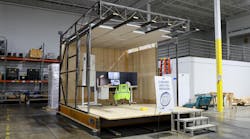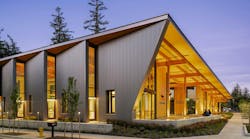On the money
The Building Team for the new Federal Reserve Bank of Atlanta credits a two-page document with being one of the most helpful tools used to successfully deliver such a complicated structure.
“This was probably the first time that a client provided us, at the kickoff meeting, with a mission statement as detailed and clear as this one,” says Joseph Trammell, principal in charge with the project’s local architect, Smallwood, Reynolds, Stewart, Stewart & Associates (SRSSA). “This was the best mission statement I’ve ever seen. It worked because it was specific enough to identify goals.”
The bank serves the Sixth Federal Reserve District, which covers Alabama, Florida, and Georgia and portions of Louisiana, Mississippi, and Tennessee. Operating around the clock six days a week, it processes an average of 4.5 million pieces of currency ($1 to $100 bills) and 3.5 million checks a day, and ranks first among the 12 Federal Reserve Banks for check-processing volume.
Before the phased movein into its new headquarters that began in May 2001, the bank’s operations were spread over three locations. An Australian developer had assembled the 8.7-acre property at the corner of Tenth and Peachtree streets over a period of 25 years. When he went bankrupt, the property was acquired by the Bank of Nova Scotia. The site had been on the Atlanta Federal Reserve’s short list for a long time, and it purchased essentially an entire block, except for a hotel at one corner. It subsequently sold four acres to a private developer, who is constructing an office building on that property.
Wanted: A classic touch
In its mission statement, the bank was firm about two related demands: endowing its new headquarters with a classic exterior, and hiring a nationally or internationally known architect to be on the design team. When the selection process began, word got out that SRSSA was the local architect to team with, says Trammell, and at least 10 prominent firms contacted him. Robert A.M. Stern, dean of Yale University’s School of Architecture and head of his self-named New York firm, was selected to design the exterior and the interior public spaces, in large part due to Stern’s experience with classical design. “We thought, based on everything we knew about what the bank was looking for, that Stern would be a good choice,” says Trammell.
Although marble was the preferred exterior cladding material, planners initially thought they couldn’t afford it, so precast concrete was substituted. By the time working drawings were half completed, however, the price of precast had gone up enough that cladding the building in stone was deemed financially feasible. The use of white Cherokee Georgia marble &m> 264,000 sf, in 38,800 hand-set pieces &m> was“a major value-added feature obtained at no additional cost,” says Willie Russell, project executive with BIMI, the project’s joint venture general contractor. (BIMI consisted of Beers Construction Co. [now Skanska], New Jersey-based Torcon, and two minority firms, C.D. Moody Construction and The Integral Group, both of Atlanta.)
The bank also wanted to incorporate several features from its past into the new headquarters, not merely for decoration, says Trammell, but as integral components of the design. Its original boardroom, built in 1918 and relocated when the bank was moved in 1965, was reconstructed on the third floor of the new headquarters. Windows were added for the first time.
Five exterior columns and a 2,500-pound eagle sculpture, commissioned for the opening of the bank’s 1965 headquarters, were also relocated. The irreplaceable nine-foot-tall eagle, with its 16-foot wingspan, was gingerly transported two miles to the new building in what Russell describes as a “scary” operation.
Russell, formerly with Torcon and now with Skanska, came to the project with prior experience as project manager for Federal Reserve projects in Cleveland and East Rutherford, N.J.
The most challenging part of the construction was excavating next to a tunnel that encloses an Atlanta rail system station, to make room for an underground vault. “We were driving piles and digging deep foundations &m> to a depth of about 50 feet &m> in the area of the tunnel,” says Russell. “One wrong move and we’d have had a major catastrophe. Coordination was very tight.”
The cash vault, reportedly the second largest in the U.S., is situated almost entirely below grade. It is enclosed by an outer wall, an intermediate space, and an inner wall that is 30 inches thick and reinforced with five layers of steel. Motion sensors were put in place to detect any penetration of the outer wall. The project required more than 20 engineering and specialty consultants, including a materials-handling specialist and another for currency shredding and document disposal.
John Kerr, the bank’s former senior VP and its project manager, says that to keep the project moving along, the Building Team had to be cognizant of the approval process that governed the bank, which reports to the Federal Reserve Bank Board of Governors in Washington. “You need to conduct business in such a way that decisions line up when you need them,” he says. “You need to gauge project activities to make sure that the decision makers are able to make decisions when the time comes.”
Bank officials wanted the building’s front door to face Peachtree Street. The adjacent Midtown rail station, which is toward the back of the site, also dictated that a significant side entrance be provided. Security considerations ruled out the placement of a 500-vehicle parking facility beneath the building.
The building has separate loading docks for general deliveries and for check couriers. A secure dock for incoming and outgoing cash shipments is large enough to accommodate a semi-trailer truck.
Trammell says the building “is much more challenging structurally than it appears” because of its lack of repetitive elements. A structural highlight is a story-high, 110-ft-long composite concrete- and-steel truss that spans a truck dock, according toSteve Hamvas, project manager for the building’s structural engineer, Stanley D. Lindsey & Associates, Atlanta.
Atlanta-based Newcomb & Boyd was the project’s mechanical engineer. “It wasn’t a project for which you designed a system and copied it 20 times, says project manager Bob Howell. The air-handling unit specifications had 15 different operational sequences. The mechanical design was guided by a desire to create a minimum number of penetrations.
Accommodating many needs
The 746,000-sf bank headquarters houses an unusual combination of functions. The bottom floor, at 130,000 sf, is devoted entirely to processing cash; the same-size floor above, to processing checks. The third floor, which contains a cafeteria and meeting rooms, mediates between these “factory functions” and the seven 41,000-sf office floors. The bank is also home to a data center, a 5,000-sf Monetary Museum just off the lobby, and its own firing range, where security officers can maintain their marksmanship skills. Meeting space is an important component of the building, with a typical business day finding numerous business meetings involving either Federal Reserve participants or outside organizations in progress.
The unusual nature of the project enabled Trammell, who normally concentrates on management issues, to do more hands-on work. “I went to every meeting, reviewed every drawing, and worked out some of the details, “ he says.
“There probably are developers around Atlanta who were pretty disappointed that the bank didn’t see a need to have an owner’s representative from their ranks,” Trammell says. “The bank’s in-house staff did as good a job as any owner we’ve ever worked with.”
Kerr says he appreciated the level of employee input that was put into the building’s design, with one in five of the bank’s 1,200 employees participating. “We wanted to involve as many bank people as possible to create ownership and acceptance of the final project,” he says.
The bank was scheduled to have its public opening on Sept. 13, 2001. It was canceled in the wake of the terrorist attacks two days earlier.
Trammell says he has shown the Federal Reserve’s mission statements to other owners as an example of the kind of information his firm would like to obtain at the outset of a project. “To the extent that we can get other clients to do this, it will be a big help,” he says
“This project illustrates how successful partnering works,” says BIMI’s Russell. “There was never any finger-pointing. The project was the prime goal for each of the stakeholders.” BDC
The not-so-sweet smell of money
Success may smell sweet, but money, at least in the volumes being stored at a Federal Reserve Bank, does not. New bills have an odor that arises from the ink used to print them, and old bills pick up smells as they are circulated. “The smell of money is not always pleasant, so vaults have systems to control that,” says Bob Howell, project manager with Newcomb & Boyd, which designed the ventilation systems to control these obnoxious emanations.
A road map for the Building Team
John Kerr, the Federal Reserve Bank of Atlanta’s former SVP and project manager, says the mission statement outlined the bank’s expectations regarding building function, project management, site design, budget, quality, and schedule. “In effect, we tried to construct a road map for the project,” he says.
Kerr, who is now retired, says the mission statement, developed over a two-month period, was issued along with the RFPs for architect and CM services. “From day one, they had a pretty good idea of what we were looking for,” he says.
He cites language in the mission statement stipulating that the building “shall be designed from inside out for the accommodation of bank functions, and that this should strongly influence the exterior design.”
“This is a very important statement,” Kerr says. “We did not want the architect to design a monument to himself. Left alone, some architects will do that. We wanted the function of the building to drive the design of the envelope.”
The mission statement “placed a strong emphasis on functional design, signaling that functionality would take precedence over building form when a conflict between the two emerged,” says Bob Howell, project manager with the job’s mechanical engineer, Newcomb & Boyd, Atlanta.
“Many projects don’t experience that [kind of] discipline,” says Willie Russell, project executive with BIMI, the project’s joint venture general contractor. “They start with an overall goal but end up going in different directions as the result of financial, schedule, or other considerations. That didn’t happen on this project.”
Construction Costs
Sitework$5,593,414
Finishes13,658,025
Specialties1,963,572
Specialty construction4,982,949
Concrete31,223,696
Masonry, stone16,229,953
Metals4,288,993
Electrical 21,748,194
Doors, windows, glass10,497,778
Equipment1,544,424
Mechanical15,969,719
Moisture protection2,071,066
Conveying systems2,932,269
Wood2,183,442
General conditions17,167,472
TOTAL$152,054,966
Project Summary
Federal Reserve Bank of Atlanta Headquarters
Building Team
Owner/Developer:Federal Reserve Bank of Atlanta
Architect/Interior Architect: Smallwood, Reynolds, Stewart, Stewart & Associates, in association with Robert A. M. Stern Architects
Structural Engineer:Stanley D. Lindsey & Associates
Mechanical/Electrical Engineer:Newcomb & Boyd Consulting Engineers
General Contractor:BTMI (joint venture of Beers Construction Co., Torcon Inc., C.D. Moody Construction Co., and The Integral Group)
General Information
Area: 746,000 gross sf
Number of floors:10 + basement
Construction time: January 1999 to May 2001
Delivery method: Negotiated CM at Risk Contract
Project Suppliers
Curtain wall:Bruce Engineering
Exterior glazing:Viracon
Stone:Georgia Marble Company
Masonry:Trenwyth Industries
Skylights:LinEl
Life safety:Simplex Grinnell Fire Alarm
Elevators:KONE
Refrigeration:Trane
Energy management controls:Siemens
Access floor:Tate
Plumbing Fixtures:Crane
Doors:Eggers, Horton
Door hardware:Schlage, Hager, Ives, LCN, Von Duprin
Entrances, storefronts:Dawson
Tile:Floor Gres & American Olean
Carpet:Lees & Mannington, Nora Rubber Floor, Mondo Sport Impact Rubber Floor
Resilient flooring:Armstrong
Ceilings:USG tiles, with Armstrong grid
Vault Systems:HK Systems

